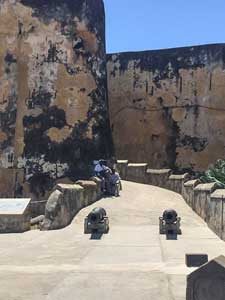MOMBASA is an island that springs with ancient beauty and beautiful sandy beaches off the coast of Kenya.
The island is embroiled in centuries if not millenniums of seagoing history where Africa, Asia and Europe converged on this tropical island on the shorelines of Kenya with purpose-driven hunger that is to conduct trade and intermingle with each other.
At the same time serving as a fascinating commercial and cosmopolitan port town on the East African coastline where both history and progress are greatly valued.
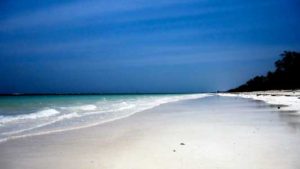
This unique blend and diversity of culture can be intoxicating and many travelers find themselves charmed by East Africa‘s biggest and most multicultural port despite its grime and sleaze, which somehow only adds to the place’s considerable allure.
The exact founding date of the city is unknown, but it has a long history which Kenyan school history books place the founding of Mombasa at 900 A.D.
It must have been already a prosperous trading town in the 12th century, as the Arab geographer Al Idrisi mentions it in 1151.

Mombasa is a Swahili founded and ruled city.
At certain times it was occupied by the Portuguese, Arabs and British and originated back in the 16th century.
Mombasa’s culture today still exhibits that of its past, historical ruins like Forte Jesus de Mombasa (Fort Jesus), an historic Portuguese fort, and the Old Town are attractions influenced by Mombasa’s trade culture, with many examples of Portuguese and Islamic architectural prowess still lingering in the city.
During the pre-modern era, Mombasa was an important center for the trade in spices, gold, and ivory.
Its trade links spread across the Indian Ocean like wildfire reaching as far as the Indian subcontinent, modern-day China and oral historians today can still recall this period of local history.
History shows that there were trade links between Mombasa and Cholas of South India.
Indeed, the city notoriously dubbed “the Island of War” has many faces, from the euphoric passion of the call to prayer over the old town, to the waves crashing against the coral beaches below Fort Jesus and the sight of a Zanzibar-bound dhow slipping over the horizon.
As the Swahili people themselves say in an old proverb: “Mombasa is famous, but its waters are dangerously deep”.
Also Mombasa‘s northern shoreline is renowned for its vibrant and exhilarating 24-hour entertainment offers, including both family entertainment (water parks, cinemas, bowling, etc.), sports (watersports, mountain biking and go karting), culinary offers (restaurants offering a wide range of specialities from Kenya, China, Japan, India, Italy, Germany and other countries) and nightlife (bars, pubs, clubs, discothèques, etc.).
This cosmopolitan tourist hub is actually an island connected by bridges and ferries to the Kenyan coast overlooking a wide harbor.
Where commercial ships mingle with traditional sailing dhows. Stretching for kilometers along the mainland to the north and south, Mombasa’s beach resorts are presided over by palm-studded strands fringed by shimmering coral reefs.
Travelers from Europe and afar congregate here to enjoy the many watersports ranging from dolphin spotting trips on traditional dhows and deep-sea fishing, to diving and snorkeling the wrecks and reefs, and basking on the sun-splashed shores.
But above all else the heart of Mombasa is located within Old Town among the many narrow winding streets.
The air is normally heavy with an ambient flow of spice-scented air.
Modern day Mombasa is a city of great diversity and life.
This is a town where all are welcomed and quickly absorbed into this great coastal melting pot of languages.
An irresistible array of languages and culture from all corners of the Indian Ocean awaits travelers who make it to Kenya’s coastal city of Mombasa as well as a diverse marine life, world-class hotels and a friendly atmosphere.
The city has a warm climate all year round making it a great destination filled with activities for all ages.
Mombasa – How to get there
Mombasa is easily accessible by air, railway and by road.
There are regular flights from major cities like Nairobi, Kisumu and others to Mombasa daily.
The city airport is about 13 km from the city center and various public transport are at a traveler’s disposal once landed including buses/matatu (public minibus) and a more private expensive option- taxis will ensure one gets to his/her destination.
There is a recently constructed modern railway from Nairobi to Mombasa that has two overnight departures each day from the two cities.
Mombasa railway station is located at the town center, between Tangana Road and Liwatoni Road that can be easily located by a traveler using handy town maps once in the city.
As a means of getting around in the city, there are numerous public transport that operate throughout Mombasa.
Commuter buses, locally known as “matatu”, are well distributed throughout the town and are the most popular and cheapest means of transport in town but they can get very crowded during rush hour.
A better option at this time would be to take a taxi, especially a registered one with a white number plate or a motorbike but ensure there is safety or a more local option are the tuktuks.
Things to Do in Mombasa
There are numerous exciting things to do in Mombasa.
From historical sites to cultural attractions, explore the exhaustive list of all the available local attractions on offer in Mombasa.
Discover new places to see and unique things to do nearby Mombasa.
Thanks to its legacy as the largest port in East Africa, Mombasa is a cultural melting pot from British, Asian, Arabic, Omanis, Indian, and Chinese immigrants have enriched the city’s architecture and cuisine, and many mosques and temples grace the city streets.
In the Old Town, where fragrant spices waft from local markets, a traveler can step back in time and explore the ancient buildings.
On the busy harbor front here, the World Heritage-listed Fort Jesus, built by the Portuguese in the 16th century, is an architectural jewel.
Beyond the city, wildlife parks, villages, and ancient ruins round out the wealth of water-based fun.

BEST BEACHES OF MOMBASA
The coastline of Mombasa is a world of natural beauty.
Turquoise seas lap the sun-bleached beaches where travelers sprawl under rustling palms.
Rainforests with abundant wildlife and birds skirt this idyllic stretch of coast and coral reefs protect the swimming areas from offshore swells.
Shelly Beach, just south of the Likoni Ferry, is the closest beach to Mombasa along the south coast.
Tiwi Beach, 17 km south of the Likoni Ferry, is a popular spot for sunbathers and snorkelers alike.
Diani Beach is the most developed area along this stretch, but still offers beautiful beachscapes among other breathtaking relaxing beaches.
European package travelers flock here to enjoy the busy lineup of water sports ranging from windsurfing, sailing, snorkeling, and diving to water-skiing and parasailing.
The various beaches south of town can be accessed by taking the Likoni ferry to the mainland in the south
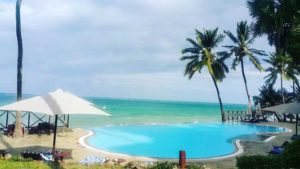
Nyali Beach – Mombasa
Nyali is renowned for its tourist potential, thanks to its tranquility and its closeness to the city that is 5km from the city and can be accessed by bus.
The beach is a sensation of pristine, calmness and quietness away from the busy city streets.
Accommodation facilities and its coast bordered with white sandy beaches protected by a coral reef is loved by divers.
Nyali also shelters many luxury hotels on almost all the seaside such as;
Nyali Beach Resort, Voyager Hotel, Reef Hotel and Mombasa Beach Hotel, altering with more affordable hotels such as the Backpackers Hotel and with numerous places of entertainment and activities for the travelers including beach volley, windsurfing, scuba diving, kite surf, jet skiing, sailing and many more others.
Diani Beach – Mombasa
Diani beach is known to be the most popular and beautiful beach in Mombasa and Kenya at large.
Located approximately 30km south of Mombasa city, the beach is an absolute haven of tranquility lying on the Indian Ocean.
Travelers can relax and enjoy the warmth of the sun or take strolls by the shores.
Diani is renowned for its coral-reefs, underwater sandbars, palm vegetation, vibrant marine life and numerous world class beach resorts.
The beach is a delightful location for swimming as well as surfing but one can participate in beach sports or take a picnic, Diani beach is the best beach for all of these.
Tiwi Beach – Mombasa
Tiwi, a small, peaceful, quiet and relaxing beach away from the crowds of the city.
Located just 18km south of Mombasa city this beach is settled in Kwale County and has its fair share of a beautiful sandy beach in Kenya.
The beach offers nature at its peak with an absolute feeling of the countryside with rich palm trees.
The beach has few by the beach side hotels that offer travelers an exquisite relaxing experience than any other beach in Mombasa.
The beach is a paradise of beauty for sun bathing lovers and for travelers searching for the ultimate peaceful beach holiday.
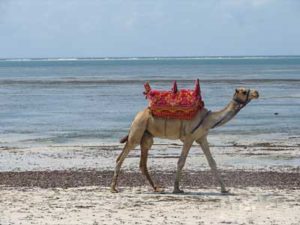
Bamburi Beach – Mombasa
Bamburi beach is located about 10km from Mombasa city center on the North Coast of this island.
It’s amazingly calm and it boasts fine soft sand and calm water, an ideal place for any traveler who seeks for the perfect beach experience.
The beach is a popular destination for sun lovers and sand seekers and is home to Mombasa Marine Park for marine life enthusiasts.
The Bamburi beach stretch also houses the Pirates public beach where travelers can swim, engage in water sport while meeting new friends during parties that are hosted in the beach.
Bamburi beach also encompasses some of fascinating beach facing hotels, resorts, villas, apartments all at a travelers reach for the perfect relaxation after a tiring day at the beach.
The beach is accessible by taxis from the city, motorbike for bike lovers and other public means like buses. Bamburi beach surely has everything for everyone.
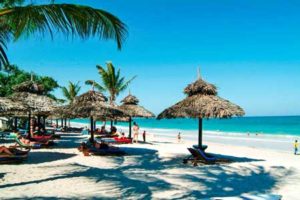
Shanzu Beach – Mombasa
Further north of Bamburi beach is Shanzu beach, located just 30km from Mombasa town, off Mombasa-Malindi Highway.
The beach is surrounded by coconut palm groves which nestles a stretch of remarkable beach resorts, hotels, bars and restaurants that serve as great relaxation spots for travelers all around the world.
The beach offers pleasant views of the sea, sheer beauty of the coast and endless water spots.
Relaxing while having a beer with exquisite views of the sea or some coconut fresh juice while reflecting and indulging with nature in Shanzu beach is an explicit experience for any traveler.
It is a perfect place for a tropical beach vacation as it also provides a variety of adventures that give travelers a remarkable experiences
HISTORICAL ATTRACTIONS in MOMBASA
Fort Jesus
This is the most visited tourist destination in Mombasa where travelers from all over the world come to bear witness of the architectural prowess of the Portuguese during the 16th century.
Prior to the construction of Fort Jesus, the Portuguese colonial headquarters was an unfortified factory at Malindi, located at the delta of the Galana River and the Indian Ocean, about 120 kilometers northeast of Mombasa.
The main objective behind the fort was to prevent the Turks from creating a base in East.
Africa along the Africa-India trade route. Between 1585 and 1588, Turkish raids reinforced this political sentiment; in 1593, after nearly a century in East Africa, the Portuguese initiated the planning and construction of a military fort in Mombasa.
By order of King Philip 1 of Portugal an Italian designer known as Giovanni Battista Cairato was handed the responsibilities of designing and overseeing the construction of the fort.
He had previously worked at Malacca, Mannar, Ormuz, Muscat, Damão, Bassein and Mombasa.
Unfortunately, Cairato never saw the completion of Fort Jesus because he died in Goa in 1596.
The fort was the final project completed by Joao Batista Cairato, whose buildings can be found throughout Portugal’s eastern colonies, from Old Goa to Old Mombasa.
Cairato, the designer of the fort, was inspired by Italian architect Pietro Cataneo, while the master builder was Gaspar Rodrigues.
Although the design of Fort Jesus is an example of Renaissance architecture, the masonry techniques, building materials and labor are believed to have been provided by the local Swahili people.
The fort was built in the shape of a man and is roughly square, with four bulwarks at its corners.
The fort is considered a masterpiece of late Renaissance military fortification.
On 11 April 1593 the fortress was dedicated and named “ Fortaleza de Jesus de Mombaça” by Mateus de Mendes de Vasconcelos the then captain of the coast who resided at Malindi.
The fort was completed in 1596, the plan was a quadrilater with four bastions:
S. Felipe, S. Alberto, S. Mathias and S. Mateus. The main gate was near S. Mathias bastion. It was designed by an Italian architect, Giovanni Battista Cairato. Mombasa became Portugal’s main trading center along the East Coast of Africa.
On entrance to the fort, travelers will be able to see a gun that was salvaged from the German warship “Königsberg”, used by the Germans during the East African campaign in World War I and later seized by British Empire forces, who took it as a trophy from German East Africa now Tanzania to Kenya.
Fort Jesus was declared a national park in 1958 and in 2011 it was declared a World Heritage Site by UNESCO and highlighted as one of the most outstanding and well-preserved examples of 16th century Portuguese military fortifications.
Fort Jesus was captured and recaptured at least nine times between 1631, when the Portuguese lost it to the Sultan of Mombasa, and in 1895 when it fell under British rule and was converted into a prison.
After the Portuguese recaptured it from the Sultan in 1632, they refurbished it and built more fortifications, subsequently making it harder for the fort to fall.
The fort was subject to an epic two-year siege from 1696-98 by the Omani Arabs, led by Saif bin Sultan.
The capture of the fort marked the end of Portuguese presence on the coast, although they briefly captured and re-occupied it between 1728 and 1729 with the help of the Swahili city-states.
The fort fell under local rule from 1741 to 1837, when it was again captured by the Omanis and used as a barracks, before its occupation by the British in 1895, after the declaration of the Protectorate of Kenya.
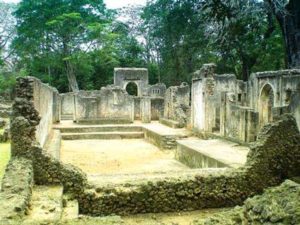
The Gedi Ruins – Mombasa
Once a prosperous and booming township along the coast of the Indian Ocean that was able to completely hide itself away from the prying eyes of the outside world between the 12th and 17th century, until its eventual demise.
Gedi a town sitting on 45 acres of land was a model of example for other settlements along the coast of the Indian Ocean that stretched from Mogadishu, Somalia all the way to the Zambezi River in Mozambique.
Now only a relic amidst the lush and dense coastal rainforest of Arabuko-Sokoke remains.
Gedi’s location along the coast of Indian Ocean and association with similar sites along the Swahili Coast made it an important trade center.
Although there are few historical documents specifically associating Gedi with Indian Ocean trade, the town is thought to have been one of the most important sites along the coast.
Gedi’s architecture and an abundance of imported material culture including pottery, beads, and coins provide evidence of the city’s rising prosperity over the course of its occupation from as early as the 11th century to its abandonment in the early seventeenth century.
Gedi’s participation in trade is believed to be the contributing factor in its founding and its later development into a city supporting an estimated population of 2,500 inhabitants at its peak.
Although Gedi remained unknown to most but not all of British East Africa’s colonists until the 1920s, the site was known by the local Mijikenda people.
The Gedi ruins were first discovered by colonialists in 1884 after a British resident of Zanzibar known as Sir John Kirk visited the site.
However, the ruins remained obscured until their subsequent rediscovery in the 1920s that is when the site began to gain attention from the British East African government.
Initial excavations at Gedi began in the late 1940s, and the site today remains one of the most intensely studied Swahili Coast settlements.
The significance of the ruins has been largely used to assess the sites role within the region in association with other sites to provide insight into the development of Swahili culture, the organization of Indian Ocean trade, the introduction and spread of Islam, and the political and economic ties between Swahili communities, through their cultural remains and their spatial relationships.
Currently, the Giriama, one of the Mijikenda tribes, maintain a large community around the Gedi ruins who view the site as a sacred and spiritual place.
Despite changes in their belief system and the prominence of Islam in the region, ancestral spirits are thought by many to reside at Gedi.
According to local tradition, the ruins are protected by the spirits of its priests. These “Old Ones” are said to curse anyone who harms the site.
The ruins are confusing, eerie and hauntingly beautiful, especially in the late afternoon. Even if a traveler is not that interested in historical sites, this is one historical site not worth missing while in Mombasa.
The Forest however, has invaded the town over the three centuries since it was deserted, and baobabs and magnificent buttress-rooted trees tower over the dimly lit walls and arches.
Since 1948, when the historical site first opened its doors to the public, the Gedi ruins has collected its fair share of ghost stories and tales of inexplicable happenings.
The earliest evidence for occupation at Gedi is a grave marker that has been radiocarbon dated back to between 1041A.D to 1278A.D, placing the original settlement of the town sometime in the eleventh or early twelfth century. The site of Gedi includes a walled town and its outlying area.
All of the standing buildings at Gedi, which include mosques, a palace, and numerous houses, are made from stone, are one-story, and are distributed unevenly in the town.
There are also large open areas in the settlement which contained earth and thatch houses. Stone “pillar tombs” are a distinctive type of Swahili Coast architecture found at Gedi as well.
Excavations began at Gedi in 1948 under the supervision of James Kirkman, lasting until 1958 with intermittent excavations occurring from the 1960s to the 1980s.
Kirkman excavated the buildings at the city’s core, including the palace, and several of the mosques and houses, as well as clearing and repairing the walls.
The Great Mosque was excavated in 1954 and the palace was excavated in 1963.
It is speculated that cowrie shells may have been the principal currency at Gedi.
Cowrie shells have been recovered in the store rooms of the houses and found in greater abundance than struck coins, represented by only two coins of Chinese origin.
The use of cowries as currency is supported by their historical use as tender in various parts of Africa, and Kirkman estimated the exchange rate of cowrie shells to the gold dinar to be 400,000 to 1. However, there are examples of locally struck coins at contemporary sites, but none have been recovered at Gedi.
Also it was speculated that beads were used as a means of trade In Gedi due to the decline in the number of beads recovered in the upper stratigraphic layers reflects a decline in their value around the fifteenth century.
Attractions in Gedi:
Mosques at Gedi
Muslim travelers Gedi town is one not to miss out. Due to the fact that Gedi was a predominantly a Muslim settlement it was vital for the township to have prayer facilities, hence the several mosques within the premises.
The mosques at Gedi contained wells and washing facilities, which were used for cleansing prior to worship.
However, they were not constructed with towers used for the call to prayer, which was more characteristic in other regions.
Gedi’s mosques were typically laid out with anterooms flanking the central room, which had a roof supported by wood beams resting on square stone pillars.
The isles created by the pillars obstructed the view of the mihrab, which were situated on the north walls in the direction of Mecca.
At Gedi, two of the mosques have been dubbed “Great Mosques.”
The mosque traditionally known as the Great Mosque is a rectangular building located within the inner wall, which was built during the fifteenth century.
The Great Mosque has three entrances and three rows of pillars in the central room supporting the roof. Above one of the entrances is a relief of a spear point flanked by a shield on its spandrel, while on the east entrance the architrave is engraved with a herringbone pattern.
The structure also has one of the deepest foundations, with its 21 inch wide walls extending four feet into the subsoil.
The second Great Mosque resided in an older portion of the city, which was inhabited from the eleventh century and located to the north of the walled city.
The structure that is standing was constructed in the fourteenth century on top of two earlier mosques from the twelfth and thirteenth centuries.
The mosque measures 26 meters in length along its north-south orientation.
Pillar tombs of Gedi
The pillar tombs at Gedi, which consist of masonry based structures topped with a pillar or column are part of an architectural style of the medieval Swahili Coastal settlements.
A common feature on the pillar tombs at Gedi are decorative recessed panels.
Although there are four large pillar tombs at Gedi, the “dated tomb,” located within the inner wall, stands out from the rest since it has on Arabic inscription with the date A.H. 802 (A.D. 1399).
Houses at Gedi
During a visit to the Gedi ruins travelers get the opportunity to see how the inhabitants of Gedi used to live.
The majority of the population of Gedi lived in mud-thatched dwellings outside the township’s core while the elite class of Gedi lived within the inner wall, majority of the buildings of Gedi are in ruins but the few that remain depict a clear picture of how life used to be in the past.
The surviving residential buildings at Gedi are all located within the inner wall and are representative of the living conditions of the elite members of Gedi society.
The four largest houses include the House on the Wall, the House on the West Wall, the House of the Dhow, and the Large House.
A cluster of smaller houses adjacent to the palace or Sheiks residence includes the House of the Chinese Cash, the House of the Porcelain Bowl, the House of the Cistern, the House of the Two Rooms, the House of the Paneled Walls, the House of the Scissors, the House of the Venetian Bead, the House of the Sunken Court, the House of the Cowries, the House of the Iron Lamp, the House of the Iron Box, and the House of the Well.
Although the houses at Gedi vary in size, their number of rooms and their layout was similar to one another.
The basic house at the site is a three-room structure which usually contained a forecourt and domestic court.
The palace of the Sheikh
The palace, a gorgeous ancient architecture which used to house the ruler of the city. It had a large central room with two anterooms, each containing its own courtyard.
A series of residential rooms were accessible from the main hall.
There were also two additional courts, the audience court and the reception court, which were accessed through different gates.
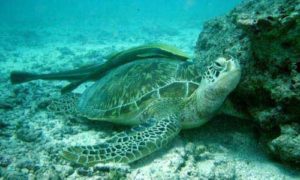
Mombasa marine national park and reserve
Home to one of the best dive and snorkeling sites in East Africa and the world as a whole, the park has been applauded by experienced scuba divers due to its mesmerizing, spellbinding and spectacular coral reefs.
Mombasa Marine National Park can only be matched in beauty and elegance by the Great Barrier Reef of Australia and the Red Sea Reef. Check out Best diving locations info here)
The Mombasa Marine National Park and Reserve was first established in 1986 enclosing part of the lagoon, back reef and reef crest habitats of the Bamburi-Nyali fringing reef and it is the most heavily visited of Kenya’s marine national parks.
Diving, snorkeling, windsurfing and waterskiing are popular traveler activities especially north of Mombasa, from Mtwapa Creek south to the entrance of Likoni where the MV Dania is a popular wreck dive site.
Travelers wishing to remain dry can view the diverse marine life from a glass-bottom boat without the inconvenience of getting wet.
Apart from being home to one of the best diving and snorkeling sites the park boasts one of the best coral gardens none alike which is another major travel attraction in the park.
The popular beaches of Nyali, Bamburi, and Shanzu all provide access to the marine park.
Nestled in between the Mtwapa and Tudor Creeks alongside the warm blue azure ocean waters of the Indian Ocean, with the swaying of coconut palm trees and white sandy beaches to be seen on the horizon.
The park is 10 square kilometers in area while the reserve covers 200 square kilometers in area.
The Mombasa Marine Park is just a single of the many marine parks that work together to preserve the fragile coral reef on the Kenyan coast that stretches for 230 kilometers along the shoreline.
The park also protects mangroves, seagrass beds and sandy beaches.
The reef plays an important role in the ocean ecosystem by providing a safe haven and food to almost one million species of marine life that call the reef home.
This is mainly due to the fact that the Marine Park is characterized by warm tropical conditions varying at the surface between 25°C and 31°C throughout the year, stable salinity regimes and moderate nutrient levels to ensure the thriving and prosperity of the marine organisms.
The various colors, shapes and sizes of the coral are incredible and some of the species that one may see in the Indian Ocean are the brain coral, pavona coral, open-branched staghorn coral, acropora coral and favia coral.

Aquatic sea life thrives in the park and many species are represented, such as sea urchin, crab, starfish, octopus, jellyfish, sea cucumber, stone fish, Seahorses, stingrays, and eels are among the many marine creatures that inhabit the reserve.
The thriving coral attracts a variety of fish, such as multi-colored angelfish, green parrotfish, butterfly fish, zebrafish, lionfish and small damselfish.
A traveler may also see some of the larger marine life, such as shark, rays, various turtle, including loggerhead, leatherback, hawksbill and green sea turtle and dolphin, including bottlenose, spinner and humpback.
There are also many seabirds for the bird lovers which are in large nesting colonies and internationally significant numbers of crab plover and roseate tern.
After a long day of tiring but exhilarating activities all travelers deserve expertly made meals available that serve various delicacies especially sea food at the various restaurants near the park such as;
Bougainvillea Pub and restaurant, Palms Restaurant, Sea Haven Restaurant and The Blue Lagoon Specialty Restaurant.
How to get there
Sited in the city of Mombasa about 487 km from Nairobi, the park can be reached by road from Mombasa city center, and then connected by boat from the various points along the beach which include:
Serena Gate on beach of Serena Hotel, Severin Gate on beach of Severin Hotel, Travelers Gate on beach of Travelers Hotel, Nyali Gate at Mombasa Marine Park Headquarters and Voyager Gate at Voyager water sport Area.
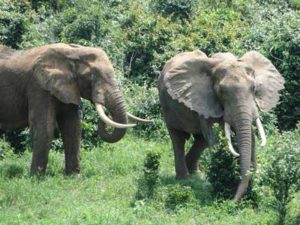
Shimba Hills National Reserve – Mombasa
Nestled at an altitude of 400 meters above the coastal beaches of Mombasa is the Shimba Hills National Reserve, cooling winds off the Indian Ocean keep the temperatures quite comfortable and refreshing within the reserve.
The topography of the landscape includes many breathtaking natural scenic features consisting of woodlands, grasslands, waterfalls, picturesque hills, lily-topped ponds and rainforests which have on offer spectacular and magnificent vistas amidst an equatorial forest awaiting travelers.
The Shimba Hills National Reserve is one of the largest coastal rainforests in East Africa after the Arabuko-Sokoke Forest where a great diversity of Kenya’s plant and animal species are found, many of which are rare and endangered.
The reserve covers an area of 300 square kilometers (24,000 hectares) and is protected by the Kenya Wildlife Services (KWS).
It is located some 33 kilometers south of the Mombasa Island and 15 km from the coast whereby the reserve offers travelers a peaceful and a much needed getaway from the hustles and bustles of the coastal beach resorts of Mombasa.

The protected status of the reserve dates back to 1903 when the Shimba Hills was gazetted as a National Forest, and in 1924, sections of the surrounding grasslands were added.
Over time, other important habitats were added to the protected area creating what is now known as the Shimba Hills National Reserve.
There are 153 km (95 miles) of roads within the national reserve.
The reserve is an important area for plant biodiversity where over 50% of the 159 rare plant species in Kenya are found, including some endangered species of cycad and orchids.
The dense forests of Shimba Hills National Reserve offer many scenarios for a traveler to be able to see diverse denizens amidst lush flora.
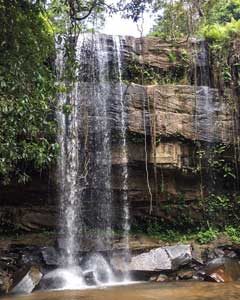
This coastal ecosystem affords unspoiled distinct wildlife viewing and exploration.
The Shimba Hills National Reserve is perfectly situated for a day trip if the traveler is staying in Mombasa or Diani Beach.
Nicknamed the sable antelope paradise since Shimba Hills National Reserve is home to the last breeding herd of these exquisite and beautiful animals.
They are among Kenya’s largest antelope, with black coats and long, scimitar shaped horns, which they were hunted for in the past.
They may be seen grazing early or late in the day around Buffalo Ridge and hiding within the thick forest camouflage during the day in order to keep cool, travelers should keep a lookout for these large ebony colored antelope with their scimitar shaped horns.
There are about 100 sable antelopes in the reserve whereby the male sables are demanding to locate as they tend to remain isolated from the herd, but females gather in small groups, making them easier to track and observe.
The reserve is well known for its large density of African elephant population, there are estimated to be approximately 700 elephants in the reserve.
This population is extremely high in comparison to the area of the reserve and due to this the elephants cause significant damage to vegetation and threatening the endangered plant life. Conflict between humans and elephants has also reached critical levels.
In the early 2000’s the population of elephants became unsustainable this led in 2005 KWS translocate over 150 elephants to Tsavo East National Park, it was described at the time as “the single largest translocation of animals ever undertaken since Noah’s ark”.
However there are still over 500 elephants in the reserve, which causes tense human wildlife conflicts with the subsistence farmers in the area.
To help reduce this conflict the Mwalunganje Elephant Sanctuary was established to provide a route for the elephants to leave the reserve and it shares a common boundary with Shimba Hills National Reserve.
The remainder of the reserve boundary is fenced to prevent the elephants from invading farmland.
Game drives allow the traveler into the secret and mysterious world of Shimba Hills Reserve’s wildlife.
Whether the traveler desires large roaming mammals or scampering small creatures, these activities give the traveler insight into the Shimba Hills ecosystem from both a macro and micro viewpoint.
In addition to elephants, there are also buffalo, waterbucks, hyenas, warthogs, leopards, baboons and monkeys such as; Syke’s, colobus and vervets.
Maasai giraffes and ostriches have also been reintroduced to the park. But due to the thick nature of the forest, game viewing is not ideal and as rewarding as on the savannahs, as many animals spend their time deep in the forest.
The animals hide in the shade of the forest in order to keep cool until the early evening. However, travelers may see the rare sable antelope and many birds on your visit the best views are from the eastern side of the park near Giriama Point, as the animals move towards the rivers to drink.
The inability of the traveler to spot wild game during game drives is not necessarily a bad thing, as it makes the wildlife encounters that you do have, that much more spectacular and wondrous.
The best time of day to go for a game drive would be in the late afternoon, when the cooler temperatures lure the animals out of the shade and seek water.
While there are no large or iconic predators in the reserve, the traveler may subtly spot serval, genet, civet cats and other smaller carnivorous hunters when staying for a longer period in the reserve.
Another unique thing to do at Shimba Hills National Reserve during the night includes taking a guided night drive.
The travelers may see leopards and cheetahs, and will certainly hear the hyenas howl in the eerie darkness.
Travelers can also buy unique souvenirs at the gates, a paper that is handmade from elephant dung!
Even the smallest tenants are well-represented, with more than 295 butterflies joining many other insects, from an army of safari ants to the rolling dung beetles.
These tiniest of creatures, as well as small mammals, support a healthy population of frogs, geckos, lizards, pythons and other reptiles and amphibians.
The forest is also an important bird area and is endowed with more than 230 types of avi-fauna such as;
African hawks, guinea-fowls, fish eagles, falcons, hornbills and numerous other feathered flyers while the grasslands hold localized species such as red-necked-Spur fowl, Croaking Cisticola and Zanzibar Red Bishop.
One of the many attractions on offer to travelers coming to Shimba Hills is the impressive Sheldrick Falls, a picturesque setting for picnics and swimming in a natural pool.
The falls which cascade 25m over the escarpment were first discovered by the late David Sheldrick, founder of the Sheldrick Wildlife Trust, who once explored the area of Shimba Hills, whilst flying over the area he discovered a hidden waterfall within the Shimba Hills National Reserve, and consequently had the falls named after him.
Guided forest walks are available whereby there is a scenic 2km footpath that takes travelers up to an hour to walk each way.
Necessary things to carry during the hike are; a hat, sunscreen and water to drink, also keeping a sharp lookout for elephants and buffalos is of great importance as they are present in the reserve.
A ranger will accompany hikers free of charge from 10-3pm daily.
Also in the reserve is Pengo Hill standing at 450m high which offers a magnificent view of the local landscape.
Elephants may be viewed through binoculars from the summit of Pengo Hill, The Tsavo plains, along with Mount Kilimanjaro on a clear day and ocean views as far as Chale Island.
Travelers can also go for sundowners on Pengo Hill, which faces west and witness while the sun sets on this coastal jungle few kilometers from the Indian Ocean.
How to get there – Shimba Hills National Reserve
From Mombasa, take the ferry at Likoni to access the southern coastline where Diani and Tiwi beaches are.
Then, take the main coast road 10 km southwards until you join the main crossroad. Take the road climbing to Kwale Town.
The main gate is located at 1 km from the Kwale road and 3 km from Kwale Town.
By air travelers can reach the reserve where direct flights from Moi International Airport are being chartered daily into the airstrip located within the reserve.
Best time to visit – Shimba Hills National Reserve
Like any other nature-centric Kenyan destination, Shimba Hills National Reserve experiences two dry seasons and two rainy seasons. Peak tourist season occurs from July to October, coinciding with the long dry season.
Climate
As Shimba Hills National Reserve is situated slightly inland from the coast, it is cooler and the landscape is often shrouded in mist in the morning which is a benefit of coastal breezes from the Indian Ocean.
The reserve has a warm tropical climate and a mean annual temperature of 24 degrees centigrade.
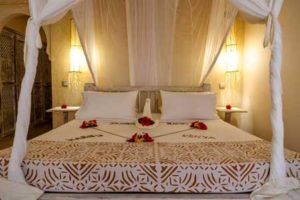
Accommodations
Travelers planning for a night’s stay at the reserve are recommended to lodge at the deluxe Kutazama Lodge in order to complete your tranquil wilderness vacation, the other option is the budget Shimba Hills Lodge.
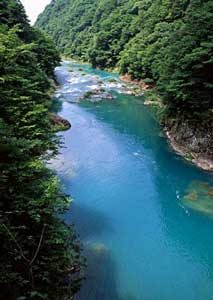
The Arabuko-Sokoke Forest Reserve
A haven for endemism, the Arbuko-Sokoke contains a host of endemic vegetation, mammals and an array of birds.
The Arabuko-Sokoke forest contains three different types of forests namely; the Cytometry-dominated forests and thickets that cover more than half of Arabuko-Sokoke Forest Reserve, the Brachystegia-dominated woodlands also known as Miombo woodlands, which is airy and beautiful for travelers to walk through.
Birds and butterflies are more visible here due to the open canopy.
Lastly the Mixed Forests which is dominated by species like Hymenaea verrucosa and Manilkara sansibarensis, the dense vegetation in this forest type that creates a tropical atmosphere as travelers walk or drives through it, the real feel of being “in the woods” is truly experienced in this part of the forest.
The forest was first protected as a Crown Forest in 1943, and was gazetted in the 1960s.
The Arabuko-Sokoke Forest Reserve covers an area of 420 square kilometers and managed by Kenya Forest Service (KFS).
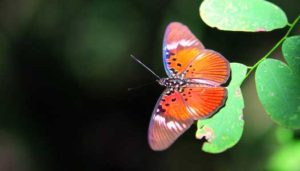
It is the largest and most intact coastal forest in East Africa, with more than 24 rare and endemic mammals, birds and butterflies.
The reserve is home to 20 percent of Kenya’s bird species and 30 percent butterfly species that are found in the whole country.
Within the forest reserve is the Arabuko-Sokoke National Park which is only a small portion of the Arabuko-Sokoke Forest Reserve, a few square kilometers in size and is located on the north-western edge of the forest.
The National Park was gazetted only in the late 1980s and in fact straddles the Forest Reserve boundary with about 50% lying outside the boundary.
Kenya Forest Service (KFS) charges an entry fee at the point of entry to promote forest conservation.
Trained guides are available to help travelers explore the forest. The guides are members of Arabuko-Sokoke Forest Guides Association (ASFGA) and charge as per the time spent and service rendered.
Enquiries about these services will be available to the traveler at the point of entry.
The forest has a network of driving tracks and walking trails. Many sections of the forest are accessible by small cars but for best access to all tracks, a 4WD is recommended.
Driving is the easiest way to see transitions between the different forest types but one learns more about the forest by walking.
The forest has 40 recorded mammal species including African Elephant, African Buffalo, African Civet, Caracal, Sykes’s Monkeys, Blotched Genet, Yellow Baboons and Lesser Galago (or bush baby).
Some of Kenya’s rarest mammals are found here, including the Golden-rumpled Elephant-shrew, an endemic elephant shrew the size of a rabbit is the most noticeable of the park’s endemic mammals, the Sokoke Bushy-tailed Mongoose and Adder’s Duiker.
The forest is constantly under threat due to the desire by the local people for more land space in order to carry out various activities, it has led to initiatives being set-up by several national and international conservation organizations in order to work with the Kenya Wildlife Service in protecting the park.
The Arabuko-Sokoke Forest protects many endemic and near endemic species.
The Clarke’s weaver is completely endemic to the forest, while the eponymous Sokoke scops owl, Sokoke pipit, and the Amani sunbird and spotted ground thrush are found only here and in a forest fragment in Tanzania.
The reserve adjoins Mida Creek, a mangrove forest that is an important shorebird wintering ground where bird-loving travelers will have the time of their lives, the creek protects species such as the Terek sandpiper and the crab plover.
There are over 270 species of birds recorded in the forest including several rare and endemic species.
The Clarke’s Weaver is only found in Arabuko-Sokoke and another area 30 kilometers further north of Arabuko-Sokoke in the entire world. Other globally threatened bird species found in the reserve include:
Amani Sunbird, East Coast Akalat, Sokoke Scops Owl, Sokoke Pipit, and the Spotted Ground Thrush.
Other birds restricted to Kenyan coastal forests are also found here, making it a great place to visit.
The forest also has 49 reptile and 25 amphibian species among them are; Boomslang, Green Mamba, Rock Python, Forest Cobra, Sand Lizard and Day Geullo.
Visiting hours
The visiting hours to the forest reserve are between 6:00 am and 6:00 pm and tickets are purchased at the point of entry to the reserve.
Travelers who are keen on having a particularly early start can purchase tickets the evening before.
The best times to visit are early morning or late afternoon as most wildlife will hide from the midday scorching sun while the best time to watch birds is from dawn to around 9:00 am.
What to wear and carry
Wear comfortable walking shoes or trainers and loose-fitting lightweight clothing. A hat, sunglasses and sunscreen may also come in handy.
It is also important to carry drinking water, binoculars, camera and wildlife books especially for birds and butterflies in addition to picnic and camping equipment in case a traveler intends to stay overnight.
How to get there
The forest reserve lies along the tarmac Mombasa – Malindi highway, approximately 100 km from Mombasa town and 18 km from Malindi.
The entry is clearly signposted and traveler services are available at the offices of KFS’s Malindi Forest Zone located there.
Regular buses and flights are available from Nairobi to Mombasa and Malindi. One can also use public service vehicles or taxis from Mombasa, Malindi and Watamu.
Accommodations
Travelers can enjoy a wide range of accommodation facilities outside the reserve that cater and suits all budget levels, as there are currently no accommodation facilities inside the reserve.
OTHER ATTRACTIONS – MOMBASA
Haller Park from a wasteland to an ecological haven.
A flower amidst a bush of thorns, Haller Park formerly known as Bamburi Nature Trail until 1999 when it was renamed in honor of the Biologist Dr. Haller Wildlife Park was a former disused quarry, reborn as a small private game sanctuary.
Rene Haller who in 1971 began an inspirational task of turning the once a wasteland quarry into a thriving ecological haven.
The park is a unique hotspot situated on the Northern Coast of Mombasa along the Mombasa Malindi road, next to the Bamburi Portland Cement Company.
Dr. Rene together with his team rehabilitated the southern part of the Quarry that comprised of 75 hectares and the northern part which was 11 square km.
The initiative carried out by Dr. Haller and his team to “green” the quarry bore extraordinary fruits which literally blossomed the area into a lush tropical beauty.
Haller Park is now fully stocked with a wide variety of game including Giraffe, Eland, Hippo, Oryx and snakes. Haller Park also provides a home to the cheeky Vervet monkeys.
The restoration and rehabilitation of the park was completed in 1984 and at the same time is when the park first opened its doors to the outside world.
The park received a whopping 20,000 plus travelers in its first year since then the number of travelers to the park has never gone into recession, on the contrary, the number of travelers to the park is staggering and overwhelming.
Today, the park is home to a vibrant ecosystem consisting of grasslands, forests, animals and lakes.
Travelers get to have the unique opportunity of a close up contact with variety of animal species in the park through a guided educational tour.
The guided tours apart from being tailored to every traveler’s specific need are usually carried out by professional guides who are fluent in few different languages such as English, French, German, Italian and Swahili.
Animals which are not so easily seen inhabit the fenced area, where each play an important role in ensuring the thriving of this unique Nature Trail’s ecosystem, and almost all of them utilize a different feeding niche.
The different species seen are hippos, giraffes, buffalos, zebras, waterbucks, elands and Oryx.
The bushbuck, suni and duiker are not easily seen as they tend to scamper away upon hearing any sounds.
Also willing travelers can enjoy the opportunity of feeding the Rothschild giraffes which is an endangered species on the African continent.
During which a traveler can enjoy a spectacular view of watching Sally, Potty and Cleo, the renowned hippos of the area that usually feed at around 4pm daily.
The park became an internet sensation in the early 2000 due to the bond that was developed between an interspecies couple between a tortoise and a hippo.
The then 130-year-old tortoise nicknamed Mzee, adopted Owen, an orphaned hippo where they became inseparable like in the famous movie “Bonnie and Clyde” up to March 2007 when death did them apart.
A fish farm project was started alongside the rehabilitation and reforestation project in 1971 as part and parcel of Haller Park.
Rene Haller created a fish tank system, with the purpose of giving fish a chance to swim in a constant current like in the open sea waters.
A tilapia farm was also created in 1980 because of the success of the fish tanks.
Birds are also abundant in the park counting to more than 160 species which have also been introduced to the area including weaver birds, cranes, owls, eagles, kites, cranes, ibis, sandpipers, herons, egrets, pelicans, storks the list is endless, making it a must visit place for all bird lovers.
Walking and cycling paths wind through the groves of casuarina, and a reptile park, palm garden and crocodile pens are just a few of the attractions on offer in the park.
Soon after the park was rehabilitated the area attracted the interest of people.
Due to the littering problem from visitors, Dr Haller realized that some sort of order was needed. Hence the idea of the Nature Trail was born.
This is particularly enthralling for the travelers up to for a romantic forest adventure with their spouses or loved ones through the peaceful, cool and safe trails of the Bamburi Forest leading to the butterfly pavilion and the Nguuni Wildlife Sanctuary where herds of ostrich, eland, and oryx are farmed.
Haller Park was the first recipient to be honored with the United Nations Environmental Program Global 500 Roll of Honor award for the unique, ecologically sound and successful rehabilitation undertaken.
The Mombasa Tusks
Located at the heart of Mombasa town, this stunning feature amazes most travelers. It is where one will find most of the banks, shops, and markets.
The pair of giant elephant tusks were built in 1956 in honor of Princess Margaret who visited Mombasa.
Located on Moi Avenue the tusks are not built of ivory as often people thought but of aluminum.
An interesting thing to note is that the tusks form dual archways over each side of the road creating the shape in entirety of a ‘M’ which might stand for Mombasa or Margaret!
There are various restaurants at the disposal of the traveler near the Mombasa Tusks such as;
The Casablanca Restaurant and club, The Canton Malaysian Chinese, Ivory Pub and restaurant, Rozina House Restaurant and Kenchic Inn.
The Bombolulu Workshops and Cultural Centre
Bombolulu Workshops is a project of the Association for the Physically Disabled in Kenya (APDK) with four sheltered workshops, a cultural center, and restaurant.
The APDK operates several workshops and a cultural center through which it offers social and economic rehabilitation and empowerment of people with disabilities.
At the cultural center, travelers can enjoy tribal dance performances and explore traditional homesteads found throughout Kenya.
Travelers can also visit the workshops and purchase the handcrafted souvenirs, which include jewelry, textiles, wood carving, and leather crafts. Proceeds help sustain the center’s work.
After touring the grounds, one can stop by the restaurant to sample Kenyan-themed delicacies.
Go-Karting
Mombasa Go-Kart is a hit with speedsters, adrenaline junkies and kids of all ages.
Zoom through the smooth concrete track in go-karts, bounce around on the off-road buggies, or learn to dig in a Bobcat excavator.
After all the excitement, travelers can sit back and enjoy a snack at the family-friendly restaurant with computer games, a large playground, and a big screen showing sporting events.
Kisite-Mpunguti Marine National Park
Traced south of Wasini Island, Kisite-Mpunguti Marine National Park is a famous tourist hotspot for snorkeling, diving, and foremost dolphin spotting which is usually undertaken from the deck of traditional dhows or “mtumbwi” as they are known in Swahili language.
The park incorporates four small islands surrounded by fish-rich coral reef.
Dolphins frolic in the Shimoni Channel, and humpback whales swim these waters between August and October.
Other marine life includes moray eels, angelfish, grouper, snappers, and green sea turtles. Deep-sea fishing is fantastic south to the Pemba channel.
The Kisite-Mpunguti Marine Park is a place not worth missing while in Mombasa.
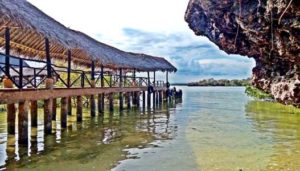
Watamu Island
Watamu is a small Swahili fishing village that has recently blossomed into a small beach resort which offers outstanding snorkeling and diving grounds to travelers coming to the island.
Located about 112 kilometers from Mombasa, the coast of Watamu is broken into three coves divided by rocky headlands.
Watamu is also a vital turtle breeding area with green and hawksbill turtles as the primary species.
For travelers who love a beach experience, Watamu beach is just 15km south of Malindi town that offers the serene opportunity to see these large, slow moving animals lay their eggs in the sand and leaving back for the ocean.
Hatching happens around 60 days later. With average temperatures in the 70 to 90 degrees Fahrenheit and relatively high humidity levels.
The beach is known for its clear waters, shading palm trees and soft white sands.
A traveler can enjoy a day out snorkeling or diving lets you cool in the midst of a very warm day, wreck and night diving are available too.
Glass-bottomed boats transport offers travelers to the reefs and provide a window to the kaleidoscopic world of coral and fish.
For travelers looking for something other than snorkeling and diving, Watamu offers windsurfing, relaxing on the beach, dolphin-watching trips, and thriving rock pools.
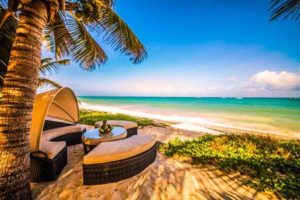
Accommodations
Watamu has on offer a wide range of hotels, from the most opulent beachside villas, affordable apartments where a traveler is pampered with top services to deluxe resorts where one can receive excellent service at affordable lodgings.

Kilifi – Mombasa
Kilifi is a small beach resort on the banks of Kilifi Creek where yachts dip about in the breeze.
One of the top tourist attractions here are the Mnarani Ruins, an ancient Swahili coastal settlement dating back to the early 14th century.
A huge baobab tree amongst the ruins is alleged to be the largest on the Kenyan coast.
Kilifi is also home to a top notch golf club for those travelers that enjoy a day out golfing.
At one time, Kilifi could only be reached by ferry but in recent years a bridge was constructed to make it more accessible to this small paradise.
Vipingo beach is also a nearby beach from Kilifi where travelers can experience beach life.
The beach is surrounded by greenly vegetation of coconut palms, the water is calm and crystal clear.
The beach is scenic but it’s always isolated with very little crowd which makes it a perfect destination for peace seekers away from public beaches.
For a great time with all the beach relaxation, Vipingo beach is the best place to visit
Nguuni Nature Sanctuary
The sanctuary neighbors the Lafarge Bamburi Cement Company on the Nguu Tatu Hills, Nguuni Nature Sanctuary is home to Giraffes, elands, Ostrich, antelope and Oryx.
The sanctuary offers travelers a close intimacy with nature and various species of wildlife, many travelers visit the sanctuary during sunsets as it looks truly stunning and enticing to the eyes.
During sunsets, Giraffes make their way to the picnic area for feeding and in fact a traveler can go ahead and feed these gentle and loved creatures without gates or barriers, an exquisite experience only available at Nguuni Nature Sanctuary.
The sanctuary is a nice place for recreation and other picnic activities and not forgetting a bird watcher’s paradise!
The Sanctuary also offers a magnificent spot for camping, barbecue sundowners and wedding ceremonies under the African sunset.
Jumba la Mtwana
Translating to “large house of the slaves”, Jumba la Mtwana was built in the 14th century and supposedly abandoned in the 15th Century, the ruins now hold mosques, a tomb and houses.
The ruins give travelers a serene yet spooky feeling! One will witness how nature and humans co-existed peacefully in the 14th century.
The Tana River Primate Reserve
A two-hour drive from Mombasa brings a traveler to the Tana River Primate Reserve, an eccentric spot for adrenalin junkies and bird watchers alike.
The Tana River is an excellent water sports spot while the riverine forests along the Tana River is home to around 200 species of birdlife.
These include the White-winged Apalis, Martial Eagle, Bat Hawk, African Open-bill Stork, African Pygmy-falcon, Scaly Babbler, Black-bellied Glossy-starling, African Barred Owlet and the Golden Pipit among many other bird species.
Ticket price for entering into the reserve is 20 USD for adults, 10 USD for both children and students.
The Hindu Temple Center
The multicultural character of Mombasa is made evident by sites such as the Hindu Temples, which are a popular tourist spot.
Inside the temples you’ll acquire knowledge about Mombasa’s past that the temple gurus are willing to share.
Fascinating images of the Hindu gods, the stone carvings on the walls, paintings, pictures and other artifacts are at tourists disposal once at the temple as they are very important to worshipers.
Travelers can join the worshipers for readings, Hindu prayers, songs and other temple activities.
The Mwaluganje Elephant Sanctuary
Mwaluganje Elephant Sanctuary is an example of ecotourism, as well as community-based conservation efforts, both of which are very recent trends in conservation management.
In this community-based program, the local people have leased their privately owned property to a community-based trust.
The trust manages the sanctuary for the conservation and preservation of the elephants. It is a valuable source of revenue for the local people, through monies generated by eco-tourism and gate entrance fees.
The area is off the Shimba Hills escarpment in Kwale County and is on the migratory route leading to Tsavo East National Reserve.
Some of the revenue generating activities include creating paper from elephant dung, bee keeping and biofuel.
Home to one of the Big Five species. The Mwaluganje Elephant Sanctuary is the residing place for more than 150 elephants.
Sitting on an area of 36 square kilometers next to the Shimba Hills National Reserve, the elephant sanctuary shares the same ecosystem as the reserve.
The sanctuary is a good example of community-based conservation, with local people acting as stakeholders in the project.
The sanctuary was opened in October 1995 to create a corridor along an elephant migration route between Shimba Hills and Mwaluganje Forest Reserve, and comprises 2400 hectares of rugged, beautiful country along the valley of the Cha Shimba River.
Travelers are treated to an extended experience in what is globally recognized as one of the top 25 biodiversity hotspots in the world.
The ecosystem is noted for its waterways shaded with indigenous trees that wind through undulating plains, cliffs and rocky outcrops, as well as a 23,736-hectare forests of Mkongani north and west to Mwaluganje, the last of the world’s coastal rain forests where ancient Cycad plant species continue to thrive.
Other attractions in the sanctuary include the “God’s Bridge,” and the “Time Rock”.
For travelers who yearn a botanical bonanza, Mwaluganje Elephant Sanctuary provides an assortment of some of the oldest species on the planet.
One such species is the dinosaur cycads which dates back almost 300 million years ago and are easily recognizable by their distinct fan shape.
Another favorite amongst travelers is the odd-shaped baobab trees that can survive many of the region’s toughest droughts.
These trees reach heights of 18 meters, and individual trees have been documented to be than several thousand years old.
How to get there
The main entrance to the sanctuary is about 13km northeast of Shimba Hills National Reserve, on the road to Kinango.
A shorter route runs from Kwale to the Golini gate, passing the Mwaluganje ticket office. It’s only 5km but the track is 4WD only.
The roads inside the park are pretty rough and a 4WD is the way to go.
Mombasa Nightlife
Night life in Mombasa is like no other. Travelers from all over the world visiting Mombasa can bump to each other in any of the famous nightclubs in the area.
Night life and entertainment in Mombasa is broad and offers something for every taste.
Many bars, pubs and nightclubs in many price ranges offer something for every taste and budget. From local bars to exclusive lounge bar, everything is available.
In the city center there are numerous coffee shops, small pubs and bars as well as some small to medium sized clubs.
Nightlife “special kind” is mainly found in the village Mtwapa, north of Mombasa famously known as “the village that never sleeps”.
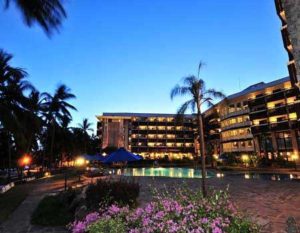
Accommodations in Mombasa
For first-time travelers to Mombasa, the best area to stay is along the northern beaches: Nyali, Mombasa, Bamburi, and Shanzu.
From here, travelers can snorkel the coral reefs of Mombasa Marine National Park, which fringes that stretch of coast.
The Haller Park nature reserve is nearby, and Mombasa’s Old Town, with Fort Jesus, is a short drive away. Here are some highly-rated hotels in these areas:
Luxury Hotels: On beautiful Bamburi Beach, Sarova Whitesands Beach Resort & Spa, with four swimming pools, tennis courts, and a PADI dive center, this are some of the popular luxury option.
For a peaceful beachfront escape, further north on Shanzu Beach, the whitewashed Serena Beach Resort & Spa fits the bill, with special family rooms and a free breakfast.
Offering great value on Mombasa Beach, north of Nyali Beach, Voyager Beach Resort features multiple pools, water sports, and a kids club. All-inclusive packages are available.
Mid-Range Hotels: On Bamburi Beach, Severin Sea Lodge offers excellent value. Its thatched bungalows and two lovely swimming pools peek out from palm-studded gardens.
Also value-packed is the nearby Travelers Beach Hotel & Club, with warm and friendly service.
Built into coral cliffs along Nyali Beach, the rooms of Bahari Beach Hotel treats guests to gorgeous views with wide glass doors that slide open to balconies and terraces.
Budget Hotels: Overlooking Tudor Creek, best western plus Creekside Hotel, with Swahili accents, sits almost equidistant from Nyali Beach and Fort Jesus, a convenient location for those who want access to both attractions.
Boasting a sweeping Bamburi beachfront location, Kenya Bay Beach Hotel offers excellent value, and the nearby Kahama Hotel has bright spacious rooms a few minutes’ walk from the white-sand shores.
 TravellerHints!
TravellerHints! 